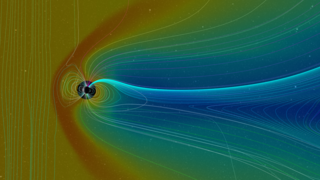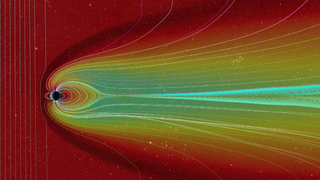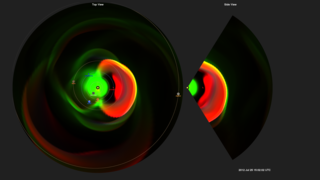Sun
ID: 4189
In an effort to understand and predict the impact of space weather events on Earth, the Community-Coordinated Modeling Center (CCMC) at NASA Goddard Space Flight Center, routinely runs computer models of the many historical events. These model runs are then compared to actual data to determine ways to improve the model, and therefore forecasts of the impacts of future space weather events.
But sometimes we don't have an actual event where we have lots of data for comparison. Extreme space weather events are one example where we must test models with a rather limited set of data.
This is a model run used to examine the consequences if a large coronal mass ejection (CME) such as The Carrington-Class CME of 2012 had actual hit Earth. Such model runs allow us to estimate consequences of a large event hitting Earth so we can better protect power grids and satellites.
Some of the conclusions from this model run are (documented in the paper linked below):
For comparison, the geo-electric field of the March 1989 storm which generated an extensive power outage in Canada (Wikipedia) had a value of only about 6 volts per kilometer; and the 2003 Halloween solar storms (see Halloween Solar Storms 2003) generated a field of about 12 volts per kilometer.

Comparative Magnetospheres: A Carrington-Class CME
But sometimes we don't have an actual event where we have lots of data for comparison. Extreme space weather events are one example where we must test models with a rather limited set of data.
This is a model run used to examine the consequences if a large coronal mass ejection (CME) such as The Carrington-Class CME of 2012 had actual hit Earth. Such model runs allow us to estimate consequences of a large event hitting Earth so we can better protect power grids and satellites.
Some of the conclusions from this model run are (documented in the paper linked below):
- The magnetopause is compressed to the point it is moved inside the orbits of our geosynchronous satellites.
- Large field-aligned currents are created on the night-side of Earth, generating large ionospheric potentials.
- At high latitudes, geo-electric fields of 26 volts per kilometer can be generated.
For comparison, the geo-electric field of the March 1989 storm which generated an extensive power outage in Canada (Wikipedia) had a value of only about 6 volts per kilometer; and the 2003 Halloween solar storms (see Halloween Solar Storms 2003) generated a field of about 12 volts per kilometer.

Related
Visualization Credits
Tom Bridgman (Global Science and Technology, Inc.): Lead Animator
Genna Duberstein (USRA): Producer
Chigomezyo M. Ngwira (Department of Physics, Catholic University of America): Scientist
Antti Pulkinnen (NASA/GSFC): Scientist
Maria M. Kuznetsova (NASA/GSFC): Scientist
Alex Glocer (NASA/GSFC): Scientist
Laurence Schuler (ADNET Systems, Inc.): Project Support
Ian Jones (ADNET Systems, Inc.): Project Support
Genna Duberstein (USRA): Producer
Chigomezyo M. Ngwira (Department of Physics, Catholic University of America): Scientist
Antti Pulkinnen (NASA/GSFC): Scientist
Maria M. Kuznetsova (NASA/GSFC): Scientist
Alex Glocer (NASA/GSFC): Scientist
Laurence Schuler (ADNET Systems, Inc.): Project Support
Ian Jones (ADNET Systems, Inc.): Project Support
Science Paper:
Modeling extreme (Carrington-type) space weather events using three-dimensional MHD code simulations
Short URL to share this page:
https://svs.gsfc.nasa.gov/4189
Data Used:
Note: While we identify the data sets used in these visualizations, we do not store any further details nor the data sets themselves on our site.
This item is part of these series:
The Carrington-Class CME of 2012
Comparative Magnetospheres
Keywords:
SVS >> Magnetosphere
SVS >> Solar Wind
GCMD >> Location >> Magnetotail
SVS >> Space Weather
SVS >> Heliophysics
NASA Science >> Sun
GCMD >> Earth Science >> Sun-earth Interactions >> Solar Activity >> Coronal Mass Ejections
GCMD keywords can be found on the Internet with the following citation: Olsen, L.M., G. Major, K. Shein, J. Scialdone, S. Ritz, T. Stevens, M. Morahan, A. Aleman, R. Vogel, S. Leicester, H. Weir, M. Meaux, S. Grebas, C.Solomon, M. Holland, T. Northcutt, R. A. Restrepo, R. Bilodeau, 2013. NASA/Global Change Master Directory (GCMD) Earth Science Keywords. Version 8.0.0.0.0
Modeling extreme (Carrington-type) space weather events using three-dimensional MHD code simulations
Short URL to share this page:
https://svs.gsfc.nasa.gov/4189
Data Used:
BATS-R-US Magnetosphere Model
Model - Community Coordinated Modeling Center (CCMC)
MHD Magnetospheric simulation
This item is part of these series:
The Carrington-Class CME of 2012
Comparative Magnetospheres
Keywords:
SVS >> Magnetosphere
SVS >> Solar Wind
GCMD >> Location >> Magnetotail
SVS >> Space Weather
SVS >> Heliophysics
NASA Science >> Sun
GCMD >> Earth Science >> Sun-earth Interactions >> Solar Activity >> Coronal Mass Ejections
GCMD keywords can be found on the Internet with the following citation: Olsen, L.M., G. Major, K. Shein, J. Scialdone, S. Ritz, T. Stevens, M. Morahan, A. Aleman, R. Vogel, S. Leicester, H. Weir, M. Meaux, S. Grebas, C.Solomon, M. Holland, T. Northcutt, R. A. Restrepo, R. Bilodeau, 2013. NASA/Global Change Master Directory (GCMD) Earth Science Keywords. Version 8.0.0.0.0














